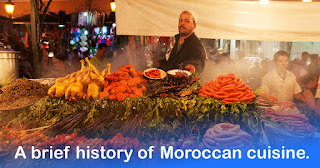A brief history of Moroccan cuisine
The coastal strip of northern Africa that comprises the
modern states of Morocco, Algeria, Tunisia and northwestern Libya is known in
Arabic as the Maghreb, which means the place of the sunset, or the west. For
several hundred years much of Spain was also part of the Maghreb. Morocco’s
position at the extreme northwestern end of the region earned it the Arabic
name al-Maghreb al- khtar, the land farthest west, and it was once the last
frontier of Islam.
Morocco’s indigenous people,
the semi-nomadic Berbers, were known to the Romans as the Mauri. They had
little contact with other cultures until about 1200 BC, when seafaring
hoenician traders developed commercial interests along the Mediterranean
coastline of North Africa and certain river shores. The defeat of the
Phoenicians by the Romans at Carthage in 146 BC brought the land of the Mauri
(Mauretania) under Roman rule. During this era, several trade routes running
from the Mediterranean coast to sub-Saharan Africa were opened. These routes
connected the Berbers in the coastal plains with the peoples of sub-Saharan
Africa, and brought another set of cultural influences and foodways to them.
The key event in shaping
Morocco’s history was the arrival of the Arabs and Islam in the 7th century. In
time the Berber clans embraced Islam. Looking to expand Muslim territory in the
name of the Prophet, the Arabs and an Islamicized Berber army began in 711 to
conquer much of the Iberian peninsula. Moorish Spain became known as al-Andalus
(Andalusia). When Spanish-born Muslims and Sephardic Jews were expelled during
the Reconquest of Spain by the Christian monarchy in the late 15th century,
they returned to Morocco as refugees and brought along their distinctive cultures.
European penetration into Morocco for foreign markets intensified in the 15th century. Portuguese adventurers established themselves in ports along.
 Reviewed by A.B
on
October 11, 2021
Rating:
Reviewed by A.B
on
October 11, 2021
Rating:






No comments: